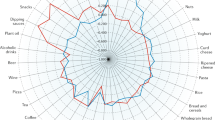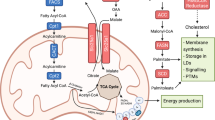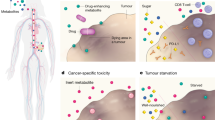Abstract
Although successful for a limited number of tumour types, the efficacy of cancer therapies, especially for late-stage disease, remains poor overall. Many have argued that this could be avoided by focusing on cancer prevention, which has now entered the arena of targeted therapies. During the process of identifying preventive agents, dietary phytochemicals, which are thought to be safe for human use, have emerged as modulators of key cellular signalling pathways. The task now is to understand how these chemicals perturb these pathways by modelling their interactions with their target proteins.
This is a preview of subscription content, access via your institution
Access options
Subscribe to this journal
Receive 12 print issues and online access
$209.00 per year
only $17.42 per issue
Buy this article
- Purchase on Springer Link
- Instant access to full article PDF
Prices may be subject to local taxes which are calculated during checkout


Similar content being viewed by others
References
Sporn, M. B. Approaches to prevention of epithelial cancer during the preneoplastic period. Cancer Res. 36, 2699–2702 (1976).
Wattenberg, L. W. Chemoprevention of cancer. Cancer Res. 45, 1–8 (1985).
Bode, A. M. & Dong, Z. Cancer prevention research — then and now. Nature Rev. Cancer 9, 508–516 (2009).
The effect of vitamin E and beta carotene on the incidence of lung cancer and other cancers in male smokers. The Alpha-Tocopherol, Beta Carotene Cancer Prevention Study Group. N. Engl. J. Med. 330, 1029–1035 (1994).
Omenn, G. S. et al. Risk factors for lung cancer and for intervention effects in CARET, the Beta-Carotene and Retinol Efficacy Trial. J. Natl Cancer Inst. 88, 1550–1559 (1996).
William, W. N., Jr., Heymach, J. V., Kim, E. S. & Lippman, S. M. Molecular targets for cancer chemoprevention. Nature Rev. Drug Discov. 8, 213–225 (2009).
Fisher, B. et al. Tamoxifen for the prevention of breast cancer: current status of the National Surgical Adjuvant Breast and Bowel Project P-1 study. J. Natl Cancer Inst. 97, 1652–1662 (2005).
Fisher, B. et al. Tamoxifen for prevention of breast cancer: report of the National Surgical Adjuvant Breast and Bowel Project P-1 Study. J. Natl Cancer Inst. 90, 1371–1388 (1998).
Vogel, V. G. et al. Effects of tamoxifen vs raloxifene on the risk of developing invasive breast cancer and other disease outcomes: the NSABP Study of Tamoxifen and Raloxifene (STAR) P-2 trial. JAMA 295, 2727–2741 (2006).
Kulkarni, G. S. et al. Evidence for a biopsy derived grade artifact among larger prostate glands. J. Urol. 175, 505–509 (2006).
Pinsky, P., Parnes, H. & Ford, L. Estimating rates of true high-grade disease in the prostate cancer prevention trial. Cancer Prev. Res. (Phila Pa) 1, 182–186 (2008).
Redman, M. W. et al. Finasteride does not increase the risk of high-grade prostate cancer: a bias-adjusted modeling approach. Cancer Prev. Res. (Phila) 1, 174–181 (2008).
Thompson, I. M. et al. The influence of finasteride on the development of prostate cancer. N. Engl. J. Med. 349, 215–224 (2003).
Zubrod, C. G. The national program for cancer chemotherapy. JAMA 222, 1161–1162 (1972).
Vaishampayan, U., Parchment, R. E., Jasti, B. R. & Hussain, M. Taxanes: an overview of the pharmacokinetics and pharmacodynamics. Urology 54, 22–29 (1999).
Zykova, T. A. et al. Resveratrol directly targets COX-2 to inhibit carcinogenesis. Mol. Carcinog. 47, 797–805 (2008).
Lee, K. W. et al. The resveratrol analogue 3, 5, 3', 4', 5'-pentahydroxy-trans-stilbene inhibits cell transformation via MEK. Int. J. Cancer 123, 2487–2496 (2008).
She, Q. B., Bode, A. M., Ma, W. Y., Chen, N. Y. & Dong, Z. Resveratrol-induced activation of p53 and apoptosis is mediated by extracellular-signal-regulated protein kinases and p38 kinase. Cancer Res. 61, 1604–1610 (2001).
Shim, J. H. et al. (-)-Epigallocatechin gallate regulates CD3-mediated T cell receptor signaling in leukemia through the inhibition of ZAP-70 kinase. J. Biol. Chem. 283, 28370–28379 (2008).
He, Z. et al. Fyn is a novel target of (-)-epigallocatechin gallate in the inhibition of JB6 Cl41 cell transformation. Mol. Carcinog. 47, 172–183 (2008).
Ermakova, S. P. et al. (-)-Epigallocatechin gallate overcomes resistance to etoposide-induced cell death by targeting the molecular chaperone glucose-regulated protein 78. Cancer Res. 66, 9260–9269 (2006).
Bode, A. M., Ma, W. Y., Surh, Y. J. & Dong, Z. Inhibition of epidermal growth factor-induced cell transformation and activator protein 1 activation by [6]-gingerol. Cancer Res. 61, 850–853 (2001).
Jeong, C. H. et al. [6]-Gingerol suppresses colon cancer growth by targeting leukotriene A4 hydrolase. Cancer Res. 69, 5584–5591 (2009).
Jung, S. K. et al. Myricetin suppresses UVB-induced skin cancer by targeting Fyn. Cancer Res. 68, 6021–6029 (2008).
Jung, S. K. et al. Myricetin inhibits UVB-induced angiogenesis by regulating PI-3 kinase in vivo. Carcinogenesis 31, 911–917 (2010).
Jung, S. K. et al. Myricetin suppresses UVB-induced wrinkle formation and MMP-9 expression by inhibiting Raf. Biochem. Pharmacol. 79, 1455–1461 (2010).
Boutros, M. & Ahringer, J. The art and design of genetic screens: RNA interference. Nature Rev. Genet. 9, 554–566 (2008).
Iorns, E., Lord, C. J., Turner, N. & Ashworth, A. Utilizing RNA interference to enhance cancer drug discovery. Nature Rev. Drug Discov. 6, 556–568 (2007).
Moffat, J. & Sabatini, D. M. Building mammalian signalling pathways with RNAi screens. Nature Rev. Mol. Cell Biol. 7, 177–187 (2006).
McInnes, C. Virtual screening strategies in drug discovery. Curr. Opin. Chem. Biol. 11, 494–502 (2007).
Irwin, J. J. & Shoichet, B. K. ZINC--a free database of commercially available compounds for virtual screening. J. Chem. Inf. Model 45, 177–182 (2005).
Bernstein, F. C. et al. The Protein Data Bank: a computer-based archival file for macromolecular structures. J. Mol. Biol. 112, 535–542 (1977).
Xiang, Z. Advances in homology protein structure modeling. Curr. Protein Pept. Sci. 7, 217–227 (2006).
McWilliam, H. et al. Web services at the European Bioinformatics Institute-2009. Nucleic Acids Res. 37, W6–W10 (2009).
Cheng, K. W., Wong, C. C., Wang, M., He, Q. Y. & Chen, F. Identification and characterization of molecular targets of natural products by mass spectrometry. Mass Spectrom. Rev. 29, 126–155 (2010).
Rix, U. & Superti-Furga, G. Target profiling of small molecules by chemical proteomics. Nature Chem. Biol. 5, 616–624 (2009).
Harriman, D. J. & Deslongchamps, G. Reverse-docking study of the TADDOL-catalyzed asymmetric hetero-Diels-Alder reaction. J. Mol. Model 12, 793–797 (2006).
Dixon, S. L. et al. PHASE: a new engine for pharmacophore perception, 3D QSAR model development, and 3D database screening: 1. Methodology and preliminary results. J. Comput. Aided Mol. Des 20, 647–671 (2006).
Nagarajan, S. et al. IKKbeta inhibitors identification part I: homology model assisted structure based virtual screening. Bioorg Med. Chem. 17, 2759–2766 (2009).
Perez-Sanchez, H. & Wenzel, W. Optimization methods for virtual screening on novel computational architectures. Curr. Comput. Aided Drug Des 7, 44–52 (2010).
Oi, N. et al. Resveratrol, a red wine polyphenol, suppresses pancreatic cancer by inhibiting leukotriene a4 hydrolase. Cancer Res. 70, 9755–9764 (2010).
Ohren, J. F. et al. Structures of human MAP kinase kinase 1 (MEK1) and MEK2 describe novel noncompetitive kinase inhibition. Nature Struct. Mol. Biol. 11, 1192–1197 (2004).
Lee, K. W. et al. Raf and MEK protein kinases are direct molecular targets for the chemopreventive effect of quercetin, a major flavonol in red wine. Cancer Res. 68, 946–955 (2008).
Lee, K. W. et al. Myricetin is a novel natural inhibitor of neoplastic cell transformation and MEK1. Carcinogenesis 28, 1918–1927 (2007).
Kang, N. J. et al. Equol, a metabolite of the soybean isoflavone daidzein, inhibits neoplastic cell transformation by targeting the MEK/ERK/p90RSK/activator protein-1 pathway. J. Biol. Chem. 282, 32856–32866 (2007).
Fischmann, T. O. et al. Crystal structures of MEK1 binary and ternary complexes with nucleotides and inhibitors. Biochemistry 48, 2661–2674 (2009).
Engelman, J. A. & Cantley, L. C. Chemoprevention meets glucose control. Cancer Prev. Res. (Phila) 3, 1049–1052 (2010).
Walker, E. H. et al. Structural determinants of phosphoinositide 3-kinase inhibition by wortmannin, LY294002, quercetin, myricetin, and staurosporine. Mol. Cell 6, 909–919 (2000).
Fisher, R. P. CDKs and cyclins in transition(s). Curr. Opin. Genet. Dev. 7, 32–38 (1997).
Sherr, C. J. & Roberts, J. M. CDK inhibitors: positive and negative regulators of G1-phase progression. Genes Dev. 13, 1501–1512 (1999).
Lee, D. E. et al. 7,3′,4′-Trihydroxyisoflavone inhibits epidermal growth factor-induced proliferation and transformation of JB6 P+ mouse epidermal cells by suppressing cyclin-dependent kinases and phosphatidylinositol 3-kinase. J. Biol. Chem. 285, 21458–21466 (2010).
Byun, S. et al. Luteolin inhibits protein kinase C(epsilon) and c-Src activities and UVB-induced skin cancer. Cancer Res. 70, 2415–2423 (2010).
Lee, K. M. et al. 5-deoxykaempferol plays a potential therapeutic role by targeting multiple signaling pathways in skin cancer. Cancer Prev. Res. (Phila Pa) 3, 454–465 (2010).
Lee, K. M. et al. Kaempferol inhibits UVB-induced COX-2 expression by suppressing Src kinase activity. Biochem. Pharmacol. 80, 2042–2049 (2010).
Hwang, M. K., Kang, N. J., Heo, Y. S., Lee, K. W. & Lee, H. J. Fyn kinase is a direct molecular target of delphinidin for the inhibition of cyclooxygenase-2 expression induced by tumor necrosis factor-alpha. Biochem. Pharmacol. 77, 1213–1222 (2009).
Kang, N. J. et al. Caffeic acid, a phenolic phytochemical in coffee, directly inhibits Fyn kinase activity and UVB-induced COX-2 expression. Carcinogenesis 30, 321–330 (2009).
Kim, J. E. et al. Cyanidin suppresses ultraviolet B-induced COX-2 expression in epidermal cells by targeting MKK4, MEK1, and Raf-1. Biochem. Pharmacol. 79, 1473–1482 (2010).
Kim, J. E. et al. MKK4 is a novel target for the inhibition of tumor necrosis factor-alpha-induced vascular endothelial growth factor expression by myricetin. Biochem. Pharmacol. 77, 412–421 (2009).
Kwon, J. Y. et al. Delphinidin suppresses ultraviolet B-induced cyclooxygenases-2 expression through inhibition of MAPKK4 and PI-3 kinase. Carcinogenesis 30, 1932–1940 (2009).
Cho, Y. Y. et al. A regulatory mechanism for RSK2 NH(2)-terminal kinase activity. Cancer Res. 69, 4398–4406 (2009).
Smith, J. A. et al. Identification of the first specific inhibitor of p90 ribosomal S6 kinase (RSK) reveals an unexpected role for RSK in cancer cell proliferation. Cancer Res. 65, 1027–1034 (2005).
Funk, C. D. Prostaglandins and leukotrienes: advances in eicosanoid biology. Science 294, 1871–1875 (2001).
Samuelsson, B., Dahlen, S. E., Lindgren, J. A., Rouzer, C. A. & Serhan, C. N. Leukotrienes and lipoxins: structures, biosynthesis, and biological effects. Science 237, 1171–1176 (1987).
Avis, I. et al. Five-lipoxygenase inhibitors can mediate apoptosis in human breast cancer cell lines through complex eicosanoid interactions. FASEB J. 15, 2007–2009 (2001).
Goulet, J. L., Snouwaert, J. N., Latour, A. M., Coffman, T. M. & Koller, B. H. Altered inflammatory responses in leukotriene-deficient mice. Proc. Natl Acad. Sci. USA 91, 12852–12856 (1994).
Gunning, W. T., Kramer, P. M., Steele, V. E. & Pereira, M. A. Chemoprevention by lipoxygenase and leukotriene pathway inhibitors of vinyl carbamate-induced lung tumors in mice. Cancer Res. 62, 4199–4201 (2002).
Moody, T. W. et al. Lipoxygenase inhibitors prevent lung carcinogenesis and inhibit non-small cell lung cancer growth. Exp. Lung Res. 24, 617–628 (1998).
Davies, D. R. et al. Discovery of leukotriene A4 hydrolase inhibitors using metabolomics biased fragment crystallography. J. Med. Chem. 52, 4694–4715 (2009).
Jones, H. E. et al. Insulin-like growth factor-I receptor signalling and acquired resistance to gefitinib (ZD1839; Iressa) in human breast and prostate cancer cells. Endocr. Relat Cancer 11, 793–814 (2004).
Warshamana-Greene, G. S. et al. The insulin-like growth factor-I receptor kinase inhibitor, NVP-ADW742, sensitizes small cell lung cancer cell lines to the effects of chemotherapy. Clin. Cancer Res. 11, 1563–1571 (2005).
Li, M. et al. Direct inhibition of insulin-like growth factor-I receptor kinase activity by (–)-epigallocatechin-3-gallate regulates cell transformation. Cancer Epidemiol. Biomarkers Prev. 16, 598–605 (2007).
Palermo, C. M., Westlake, C. A. & Gasiewicz, T. A. Epigallocatechin gallate inhibits aryl hydrocarbon receptor gene transcription through an indirect mechanism involving binding to a 90 kDa heat shock protein. Biochemistry 44, 5041–5052 (2005).
Shim, J. H. et al. Epigallocatechin gallate suppresses lung cancer cell growth through Ras-GTPase-activating protein SH3 domain-binding protein 1. Cancer Prev. Res. (Phila Pa) 3, 670–679 (2010).
Ermakova, S. et al. The intermediate filament protein vimentin is a new target for epigallocatechin gallate. J. Biol. Chem. 280, 16882–16890 (2005).
Hanahan, D. & Weinberg, R. A. The hallmarks of cancer. Cell 100, 57–70 (2000).
Luo, J., Solimini, N. L. & Elledge, S. J. Principles of cancer therapy: oncogene and non-oncogene addiction. Cell 136, 823–837 (2009).
Kobayashi, S. et al. EGFR mutation and resistance of non-small-cell lung cancer to gefitinib. N. Engl. J. Med. 352, 786–792 (2005).
Engelman, J. A. & Janne, P. A. Mechanisms of acquired resistance to epidermal growth factor receptor tyrosine kinase inhibitors in non-small cell lung cancer. Clin. Cancer Res. 14, 2895–2899 (2008).
Engelman, J. A. et al. MET amplification leads to gefitinib resistance in lung cancer by activating ERBB3 signaling. Science 316, 1039–1043 (2007).
Bode, A. M. & Dong, Z. in Phytochemicals in Health and Disease (eds. Bao, Y. & Fenwick, R.) 257–284 (Marcel Dekker, Inc, New York, 2004).
Hatzivassiliou, G. et al. RAF inhibitors prime wild-type RAF to activate the MAPK pathway and enhance growth. Nature 464, 431–435 (2010).
Herbst, R. S. & Lippman, S. M. Molecular signatures of lung cancer—toward personalized therapy. N. Engl. J. Med. 356, 76–78 (2007).
van't Veer, L. J. et al. Gene expression profiling predicts clinical outcome of breast cancer. Nature 415, 530–536 (2002).
Blackburn, E. H. Highlighting the science of cancer prevention. Cancer Prev. Res. (Phila) 3, 393 (2010).
Blackburn, E. H., Tlsty, T. D. & Lippman, S. M. Unprecedented opportunities and promise for cancer prevention research. Cancer Prev. Res. (Phila) 3, 394–402 (2010).
Shin, D. S. et al. Cryptotanshinone inhibits constitutive signal transducer and activator of transcription 3 function through blocking the dimerization in DU145 prostate cancer cells. Cancer Res. 69, 193–202 (2009).
Oh, S. H. et al. Structural basis for depletion of heat shock protein 90 client proteins by deguelin. J. Natl Cancer Inst. 99, 949–961 (2007).
Kang, N. J. et al. Delphinidin attenuates neoplastic transformation in JB6 Cl41 mouse epidermal cells by blocking Raf/mitogen-activated protein kinase kinase/extracellular signal-regulated kinase signaling. Cancer Prev. Res. (Phila Pa) 1, 522–531 (2008).
Lu, H., Chang, D. J., Baratte, B., Meijer, L. & Schulze-Gahmen, U. Crystal structure of a human cyclin-dependent kinase 6 complex with a flavonol inhibitor, fisetin. J. Med. Chem. 48, 737–743 (2005).
Lee, K. M. et al. Phosphatidylinositol 3-kinase, a novel target molecule for the inhibitory effects of kaempferol on neoplastic cell transformation. Carcinogenesis 31, 1338–1343 (2010).
Kumamoto, T., Fujii, M. & Hou, D. X. Myricetin directly targets JAK1 to inhibit cell transformation. Cancer Lett. 275, 17–26 (2009).
Kang, N. J. et al. Cocoa procyanidins suppress transformation by inhibiting mitogen-activated protein kinase kinase. J. Biol. Chem. 283, 20664–20673 (2008).
Hwang, M. K., Song, N. R., Kang, N. J., Lee, K. W. & Lee, H. J. Activation of phosphatidylinositol 3-kinase is required for tumor necrosis factor-alpha-induced upregulation of matrix metalloproteinase-9: its direct inhibition by quercetin. Int. J. Biochem. Cell Biol. 41, 1592–1600 (2009).
Lee, K. M., Hwang, M. K., Lee, D. E., Lee, K. W. & Lee, H. J. Protective effect of quercetin against arsenite-induced COX-2 expression by targeting PI3K in rat liver epithelial cells. J. Agric. Food Chem. 58, 5815–5820 (2010).
Acknowledgements
This article was supported by grants from the US National Institutes of Health CA077646, CA111536, CA111536, CA120388, ES016548 and R37CA081064, The Hormel Foundation, and the Leap Research Program (No. 2010-0029,233) and the World Class Institute Program founded by the Korea Research Foundation, Ministry of Education, Science and Technology, Republic of Korea.
Author information
Authors and Affiliations
Corresponding authors
Ethics declarations
Competing interests
The authors declare no competing financial interests.
Supplementary information
Supplementary information S1 (table)
Clinically approved chemotherapeutic agents derived from phytochemicals (PDF 182 kb)
Related links
Related links
FURTHER INFORMATION
National Center for Biotechnology Information
Rights and permissions
About this article
Cite this article
Lee, K., Bode, A. & Dong, Z. Molecular targets of phytochemicals for cancer prevention. Nat Rev Cancer 11, 211–218 (2011). https://doi.org/10.1038/nrc3017
Published:
Issue Date:
DOI: https://doi.org/10.1038/nrc3017
This article is cited by
-
Toosendanin targeting eEF2 impedes Topoisomerase I & II protein translation to suppress esophageal squamous cell carcinoma growth
Journal of Experimental & Clinical Cancer Research (2023)
-
Cirsiliol targets tyrosine kinase 2 to inhibit esophageal squamous cell carcinoma growth in vitro and in vivo
Journal of Experimental & Clinical Cancer Research (2021)
-
Manuka honey enhanced sensitivity of HepG2, hepatocellular carcinoma cells, for Doxorubicin and induced apoptosis through inhibition of Wnt/β-catenin and ERK1/2
Biological Research (2021)
-
A comparative metabolomics analysis of the halophyte Suaeda salsa and Salicornia europaea
Environmental Geochemistry and Health (2021)
-
Investigation of the cytotoxicity of bioinspired coumarin analogues towards human breast cancer cells
Molecular Diversity (2021)



